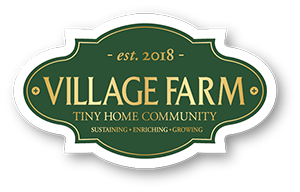So…..What exactly is a Tiny Home?
A Tiny home is also called a Park Model Recreational Vehicle or “PMRV.” It’s a unique trailer-type RV that is designed to provide temporary accommodation for recreation, camping, or seasonal use.
PMRVs (also sometimes referred to as recreational park trailers) are built on a single chassis, mounted on wheels and have a gross trailer area not exceeding 400 square feet in the set -up mode. They are certified by their manufacturers as complying with the ANSI A119.5 standard for recreational park trailers.
Our Tiny Homes, like most PMRVs, are most often used in recreational vehicle campgrounds. They may be owned by the campground and rented to guests or they may be brought in and used exclusively by their owners on a site rented or leased from the campground. They can also be placed by their owners on private property. These units are designed and built to be used for recreational/camping purposes only. They are not meant to be affixed to the property in any way, they do not improve property values in any way, and they are neither designed nor intended by their manufacturers to be used as permanent residences. Park model RVs are titled as motor vehicles by the various states just like other RV types.
What makes PMRVs unique is that they are up to 12 feet in width and 36 feet long with a peaked and shingled or metal roof. Some offer gabled windows, and siding choices of cedar, aluminum, vinyl, masonite or even split logs for a rustic look, while others are made of full solid logs. They are often designed with built-in porches, decks and/or storage areas. Many look like tiny summer cottages. Others look more like traditional but slightly longer RV travel trailers.
The Recreation Vehicle Industry Association (RVIA) operates a safety standards and inspection program that requires member manufacturers of all recreation vehicles, including park model RVs, to affix a RVIA standards program seal to every unit they build in their factories. This seal indicates the manufacturer’s certification that the unit complies with the requirements of the applicable standards. A Tiny Home, or park model RV can, always be identified by the blue and gold RVIA ANSI A119.5 certification seal (or its predecessor green RPTIA seal) affixed to the right of main door of the unit.
What a Tiny Home is Not
Although the distinctive appearance of park model RVs may sometimes lead people to think they look like small manufactured homes, appearances can be deceiving. PMRVs are actually titled and registered just like any other RV. Due to their design, small size and use as recreation, vacation and seasonal units, PMRVs are explicitly excluded from being considered or used as a manufactured home under the codes and regulations of the U.S. Department of Housing and Urban Development (HUD) specifically because they are a type of recreation vehicle (Title 24 § 3282.8(g)).
Park model RVs are built in accordance with the national safety standards set forth under a nationally recognized standard, the American National Standards Institute (ANSI) A119.5 Standard, not the HUD requirements that manufactured homes are mandated to comply with. The key distinction is that manufactured homes are single-family dwellings that are designed and built for permanent residency under standards set by the Department of Housing and Urban Development. Park models RVs, as noted, are designed and built to be used by families as a recreational, camping, or seasonal accommodation. PMRVs are not intended for, nor should they be used for, anything other than recreational camping or seasonal use. They are not permanent residences and should never be used as such.
Like RV motor homes, travel trailers and fifth-wheel trailers, park model RVs are built to ensure safety but are not required to meet the building codes or installation codes that stick-built or manufactured homes are required to meet. They are designed to remain on their axles and wheels, ready for movement and are not connected to the ground by footers, foundations, or columns (some local units of government do require them to be anchored to the ground due to excessive local winds, but even then they can easily be detached in minutes with only hand tools).
PMRVs are not housing. There is no practical difference in the use of PMRVs than travel trailers or fifth-wheel trailers. They are not ‘improvements’ to campgrounds any more than a travel trailer placed and used in a campground is. They are simply one choice among many in the RV camping environment.
Information provided by: rvia.org

